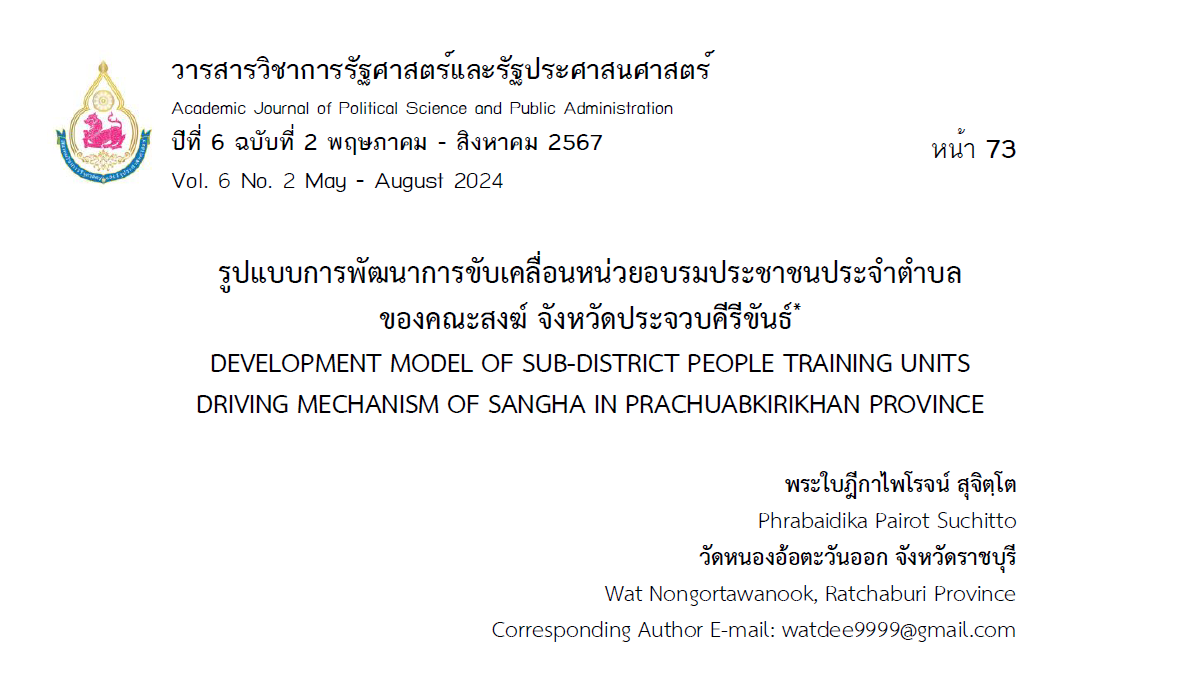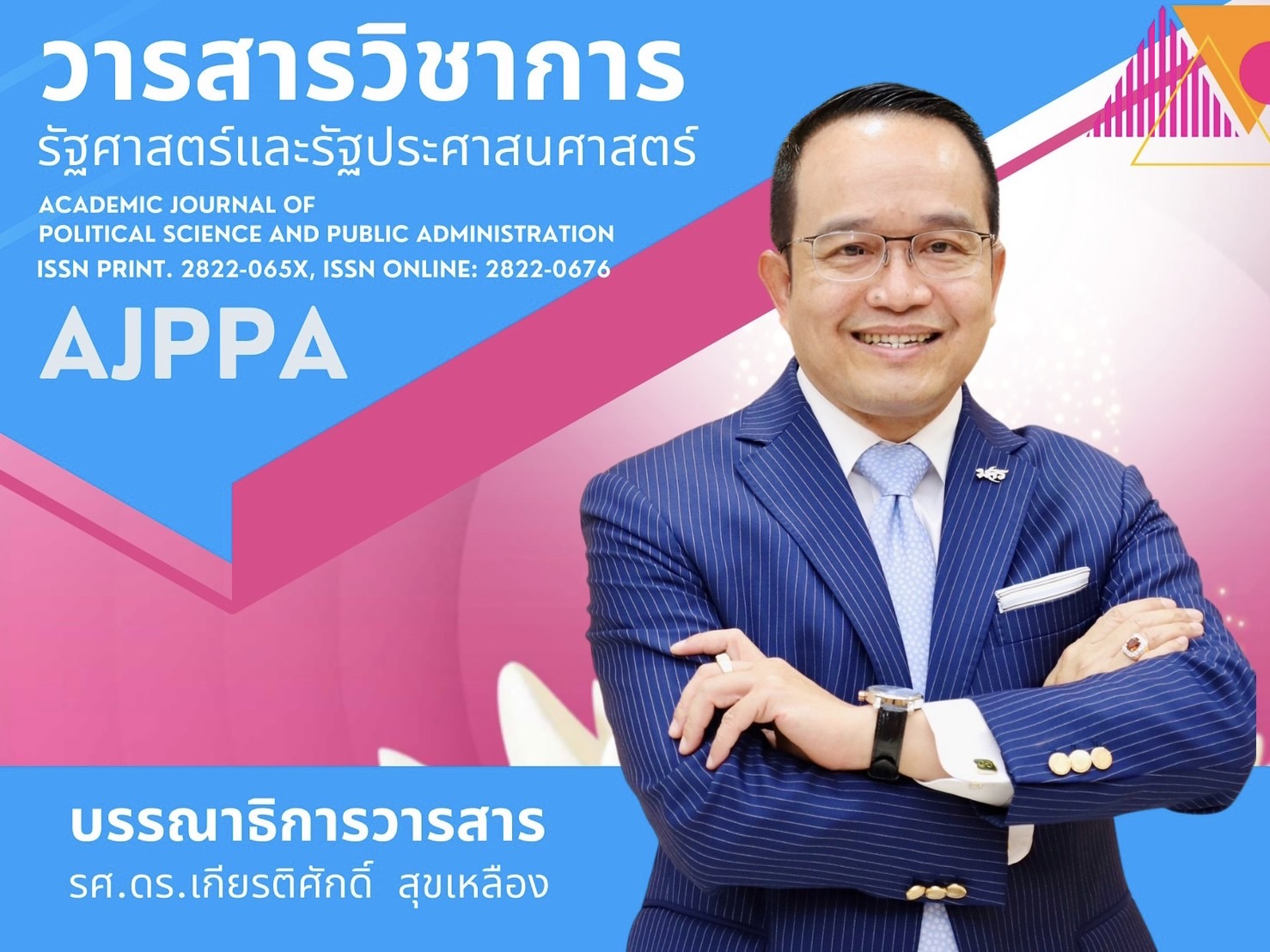รูปแบบการพัฒนาการขับเคลื่อนหน่วยอบรมประชาชนประจำตำบล ของคณะสงฆ์ จังหวัดประจวบคีรีขันธ์
คำสำคัญ:
รูปแบบ, การพัฒนา, การขับเคลื่อน, หน่วยอบรมประชาชนประจำตำบลบทคัดย่อ
บทความวิจัยนี้ มีวัตถุประสงค์เพื่อ 1. ศึกษาสภาพทั่วไปและปัญหาอุปสรรคการขับเคลื่อนหน่วยอบรมประชาชน 2. ศึกษากระบวนการขับเคลื่อนหน่วยอบรมประชาชน 3. นำเสนอการพัฒนาการขับเคลื่อนหน่วยอบรมประชาชนประจำตำบลของคณะสงฆ์จังหวัดประจวบคีรีขันธ์ ใช้ระเบียบวิธีวิจัยเชิงคุณภาพ โดยใช้แบบสัมภาษณ์เชิงลึกที่มีค่าดัชนีวัดความเที่ยงตรงเชิงเนื้อหา ผู้ให้ข้อมูลสำคัญ 25 รูปหรือคน และใช้การสนทนากลุ่มเฉพาะ โดยผู้ทรงคุณวุฒิ 8 รูปหรือคน วิเคราะห์ข้อมูลด้วยเทคนิค การวิเคราะห์เนื้อหาประกอบบริบท
ผลการวิจัยพบว่า มีจุดแข็ง ด้านกระบวนการทำงานร่วมกันในพื้นที่ มีจุดอ่อน ด้าน งบประมาณที่ได้รับการจัดสรรมีไม่เพียงพอ และรัฐบาลได้บรรจุ โครงการให้อยู่ในแผนยุทธศาสตร์ชาติซึ่งเป็นโอกาส ด้านความมั่นคงในการปฏิบัติงานและมีอุปสรรค คือ สถานการณ์การระบาดของเชื้อไวรัสโคโรน่า 2009 กระบวนการการขับเคลื่อนหน่วยอบรมประชาชนประจำตำบลของคณะสงฆ์จังหวัดประจวบคีรีขันธ์ ประจวบคีรีขันธ์ ต้องอาศัยองค์ประกอบ 4 ส่วนมาประยุกต์ใช้ร่วมกัน คือ ส่วนที่ 1 การวางแผนงานด้วยวงจรคุณภาพ PDCA ส่วนที่ 2 หน้าที่งาน 8 ประการของหน่วย อปต. ส่วนที่ 3 แนวทางปฏิบัติงานของหน่วย อปต. 7 ด้าน และ ส่วนที่ 4 การศึกษาดูงานของหน่วย อปต. ที่มีผลงานดีเด่น เพื่อใช้เป็นแบบอย่างในการขับเคลื่อนงานของหน่วย อปต. รูปแบบการพัฒนาการขับเคลื่อนหน่วยอบรมประชาชนประจำตำบลของคณะสงฆ์จังหวัดประจวบคีรีขันธ์ ประจวบคีรีขันธ์ ประกอบด้วยงาน 4 ขั้นตอนใหญ่ คือ ขั้นตอนที่ 1.การวางแผนการดำเนินงาน ทั้ง 8 ประการ ขั้นตอนที่ 2 การปฏิบัติงานตามแผนที่กำหนดไว้ ทั้ง 8 ประการ ตั้งคณะทำงาน แบ่งหน้าที่ กระจายอำนาจการปฏิบัติและสั่งการ ในแนวราบ ขั้นตอนที่ 3 การกำกับติดตามการดำเนินงานตามแผนทั้ง 8 แผนงาน อย่างใกล้ชิด ขั้นตอนที่ 4 การปรับปรุง แก้ไข พัฒนาข้อบกพร่องที่เกิดขึ้นจาการดำเนินการตามแผนงานทั้ง 8 ประการ
เอกสารอ้างอิง
กรมการศาสนา. (2544). วัดพัฒนา 44. กรุงเทพฯ: โรงพิมพ์การศาสนา.
พรั่ง เจนนธี. (2546). คู่มือการปฏิบัติงานหน่วยอบรมประชาชนประจำตำบล. กรุงเทพฯ: โรงพิมพ์การศาสนา.
พระครูอาทรยติ. (2563). รูปแบบการพัฒนาศาสนทายาทของคณะสงฆ์จังหวัดสุพรรณบุรี (ดุษฎีนิพนธ์พุทธศาสตรดุษฎีบัณฑิต สาขาวิชาการจัดการเชิงพุทธ). พระนครศรีอยุธยา: มหาวิทยาลัยมหาจุฬาลงกรณราชวิทยาลัย.
พระครูวิสุทธิสีลาภิวัฒน์. (2563). การขับเคลื่อนแผนยุทธศาสตร์การปฏิรูปกิจการพระพุทธศาสนาด้านการปกครองของคณะสงฆ์จังหวัดสระบุรี (ดุษฎีนิพนธ์พุทธศาสตรดุษฎีบัณฑิต สาขาวิชาการจัดการเชิงพุทธ). พระนครศรีอยุธยา: มหาวิทยาลัยมหาจุฬาลงกรณราชวิทยาลัย.
พระมหาสหัส ฐิตสาโร. (2551). การบริหารองค์การคณะสงฆ์ (รายงานการวิจัย). พระนครศรีอยุธยา: มหาวิทยาลัยมหาจุฬาลงกรณราชวิทยาลัย.
วิทยา จันทร์แดง. (2544). การพัฒนารูปแบบการบริหารจัดการชุมชนเข้มแข็งตามแนวปรัชญาเศรษฐกิจพอเพียงในเขตจังหวัดภาคกลางตอนบน (วิทยานิพนธ์รัฐประศาสนศาสตรดุษฎีบัณฑิต). ปทุมธานี: มหาวิทยาลัยราชภัฏวไลยอลงกรณ์ ในพระบรมราชูปถัมภ์.
สำนักงานพระพุทธศาสนาจังหวัดประจวบคีรีขันธ์. (2562). สถิติวัดในจังหวัดประจวบคีรีขันธ์ ปี 2562. สืบค้น 10 กันยายน 2566, จาก http//www.free
webs.com/kamphengphet.

ดาวน์โหลด
เผยแพร่แล้ว
รูปแบบการอ้างอิง
ฉบับ
ประเภทบทความ
หมวดหมู่
สัญญาอนุญาต
ลิขสิทธิ์ (c) 2024 วารสารวิชาการรัฐศาสตร์และรัฐประศาสนศาสตร์

อนุญาตภายใต้เงื่อนไข Creative Commons Attribution-NonCommercial-NoDerivatives 4.0 International License.




